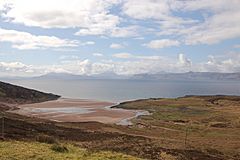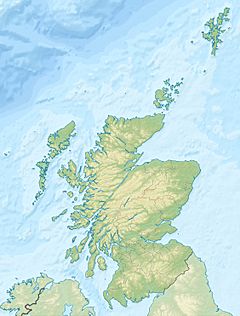Sand, Applecross facts for kids

Sand Bay and the Inner Sound
|
|
| Location | Applecross Peninsula |
|---|---|
| Region | Wester Ross, Scotland |
| Coordinates | 57°28′13″N 5°52′0″W / 57.47028°N 5.86667°W |
| Type | rock shelter |
| Site notes | |
| Excavation dates | 1999, 2000 |
| Archaeologists | Scotland’s First Settlers project (SFS) |
Sand is an exciting archaeological site located on the Applecross Peninsula in Wester Ross, Scotland. It's a place where scientists have found amazing clues about people who lived there thousands of years ago!
The site is a rock shelter right on the coast, facing the Inner Sound. This area is in western Scotland, just north of the small town of Applecross.
Contents
Discovering Ancient Homes
For a long time, people knew about a few "shell middens" in the area. A midden is like an ancient trash pile, often made of shells, bones, and broken tools. These middens were rare signs of people from the Mesolithic period, also known as the Middle Stone Age.
Scientists chose the rock shelter and shell midden at Sand for a closer look. They wanted to learn more about these shell middens around the Inner Sound, which is the water between the Isle of Skye and the mainland of Scotland.
The First Settlers Project
A big research project called Scotland’s First Settlers (SFS) started to explore how early people lived along the western coast. They already knew about other ancient sites nearby, like An Corran on Skye.
In 1999 and 2000, the project team searched the area. They found 104 new sites that no one knew about before! Most of these were caves or rock shelters. They also found 21 "lithic scatters" (places where stone tools were made) and 9 open shell middens.
Some of these new sites might be more recent. But after digging small test pits, they found that two sites, Loch a Sguirr on Raasay and Sand in Applecross, were definitely from the Mesolithic period. This showed that many more ancient sites had survived than anyone expected!
Life in the Rock Shelter
The rock shelter at Sand is on the Applecross peninsula. It looks out west towards the islands of Skye and Raasay.
About 7,500 years Before Common Era (BCE), the first people used this rock shelter. They were skilled at making tools from antler and stone. They used local stone, but they also got special stone from the island of Rùm, which is about 30 miles (48 km) to the south. They also used stone from Staffin on Skye, about 10 miles (16 km) to the west. This shows they were able to travel across open water!
What They Ate
Over time, a huge pile of shells grew at the site, mostly from limpets. This became a large midden. Scientists found many pieces of stone that looked like "pot-boilers." These were stones heated in a fire and then dropped into water to cook food. They also found bone tools with bevelled ends, which were probably used to scoop out shellfish.
The people at Sand didn't just eat shellfish. They also hunted red deer and birds. They even had an antler harpoon, which they used to catch many different kinds of fish. These included cod, mackerel, haddock, herring, and salmon.
Ancient Art and Style
The people living at Sand also cared about decoration. They made fine beads from seashells. They also used ochre pigment, which is a natural earth color, possibly for painting.
They even found a special type of dog whelk shell. This kind of shell could have been used to make a purple dye. Imagine people thousands of years ago making their own colorful dyes!
Modern Activity at Sand
There is also a British Naval Base at Sand today. This base helps monitor underwater activity along this part of the west coast. It's part of the BUTEC establishment, which tests marine weapons. Sometimes, you can even see submarines in the waters between the Applecross Peninsula and Raasay.



